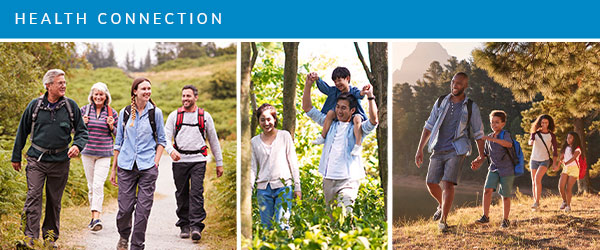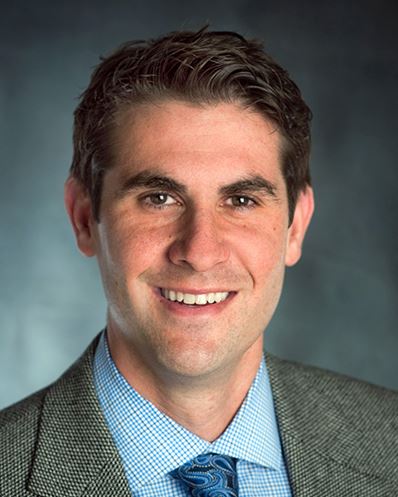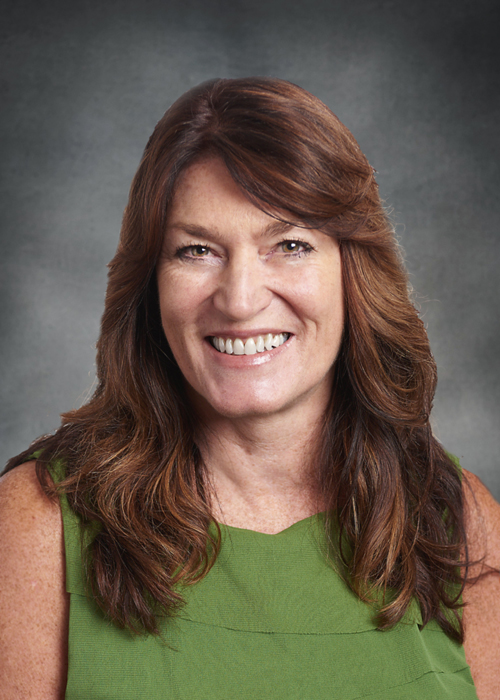Health Connection - May 2021

When Stroke Strikes: What You Need to Know

Every year, roughly 795,000 Americans will experience a stroke; 137,000 of them will die and thousands will be left with a permanent disability. With stroke, doctors use the adage “time is brain.” That’s because time is the key to limiting stroke-related brain damage. The sooner the stroke patient can get medical attention, the greater the chance that doctors can limit the damage.
A stroke occurs when blood flow to the brain is suddenly disrupted or blocked. Deprived of oxygen-rich blood, tissue in the affected part of the brain starts to die. There are a few different types of stroke:
- Ischemic stroke is usually caused by a blood clot traveling up to the brain and causing a blockage. The clot can occur in the arteries that supply blood to the brain or elsewhere in your body, such as the heart, lungs, or legs.
- Hemorrhagic stroke is when an artery bursts inside the brain. There are two types of hemorrhagic stroke. If the bleeding is inside the brain, this is known as an intracerebral hemorrhage and if the bleeding occurs in the area between the brain and the skull, it is called a subdural hemorrhage. If an aneurysm rupture occurs, then that causes a different type of bleed called a subarachnoid hemorrhage.
- Transient Ischemic Attack (TIA) or Mini-Stroke is a temporary blockage in blood flow to your brain. Symptoms may last for just a few minutes or go away in 24 hours.
Know Your Risk Factors
Although a stroke can happen to anyone, at any age, strokes are more common in people 60 and older. Women have a slightly greater stroke risk, accounting for 55,000 more stroke cases each year compared to men.African Americans have almost twice the risk of first-ever stroke compared to Caucasians. Significant medical and lifestyle-related risk factors include:
- Family history of stroke
- Previous stroke or previous episode of TIA or mini stroke
- Diabetes
- High cholesterol
- High blood pressure
- Cardiovascular disease, including atrial fibrillation and carotid artery disease
- Smoking
- Excess weight
- Drinking too much alcohol
- Bleeding disorders
- Cocaine use
- Arteriovenous malformation (AVM), a tangle of abnormal blood vessels connecting arteries and veins in the brain
- Aneurysm, a weak spot in a blood vessel that could potentially burst
Treating Stroke
Step one of stroke treatment is literally in your hands: CALL 911 IMMEDIATELY. The call triggers a protocol that paves the way for treatment. Before the patient even arrives at the hospital, paramedics can alert the hospital with a “Stroke Code,” which triggers the following preparations:
- The stroke team is ready to assess the patient as soon as the ambulance arrives
- The CT scanner is cleared and prepped for the incoming stroke patient
- The on-call neurologist is notified
- The hospital pharmacy is ready to prepare the clot dissolving medication tPA
Patients who arrive at the Emergency Department with symptoms of a stroke or mini stroke are immediately evaluated. Testing may include any or all of the following:
- Computerized tomography, or CAT scan
- CT angiogram (CTA) which provides a detailed view of the affected blood vessels in the brain
- Magnetic resonance imaging (MRI)
- Magnetic resonance angiography (MRA) of the head and neck
Stroke treatment is based on the type of stroke and the patient’s overall health. If certain criteria are met, the Emergency Department will give the patient intravenous tPA, a medication that dissolves the blood clots. This treatment can be given up to 4.5 hours after the stroke onset, or up to 3 hours after in patients older than 80.
When conventional tPA is not an option, a procedure can sometimes be performed to attempt to remove a blot clot causing a stroke. An interventional radiologist can perform this procedure, called mechanical thrombectomy, by insetting a catheter in the groin and advancing up into blood vessel that is blocked in the brain.
MarinHealth Medical Center is a Designated Primary Stroke Center offering cutting-edge treatment for stroke patients in Marin. Learn more.
Suspect a Stroke? BE FAST!
You don’t have to be a doctor to perform the simple BEFAST test. BEFAST stands for Balance, Eyes, Face, Arm, Speech, and Time. If you or someone else experiences any of these symptoms, call 911 IMMEDIATELY.
- BALANCE. See if the person is experiencing a loss of balance or coordination.
- EYES. Check if the person is having sudden vision loss or changes in vision.
- FACE. Ask the person to smile and look for facial droop or a lopsided grin.
- ARM. Have the person close his/her eyes and hold both arms out with palms facing up–Look to see if one arm drifts down, or if the person experiences weakness, tingling, or inability to move an arm or leg.
- SPEECH. See if the person is unable to speak, slurring their words, or speaking nonsense.
- TIME. To help the medical team plan treatment, note the time the symptoms started, or the last time the person was known to be well.
Reducing Your Stroke Risk
No matter what your age or health history, there are steps you can take to reduce your risk of stroke:
- Know your blood pressure and work with your doctor to get it under control
- Stop smoking
- Limit alcohol consumption
- Know your cholesterol numbers and work to with your doctor to manage it
- If you are diabetic, follow your doctor’s recommendations carefully to control your blood sugar
- Exercise regularly–as little as 30 minutes of daily exercise helps reduce your stroke risk
- Cut down on the sodium (salt) and fat in your diet
Learn more about preventing, detecting, and treating stroke by listening to this short podcast.
Board Certified in Neurology and Stroke / Vascular Neurology, John J. Panagotacos, MD is a neurologist at MarinHealth Medical Center.
Healthy at Every Age: A Women's Guide
 Do people consider you an “old soul” at 22? Are you “80 years young”? We all age differently, physically and mentally, but there are a number of things a woman needs to do to stay healthy at any age. It’s never too early – or late – to prioritize health and wellness, and these guidelines can help keep you on the right track during every decade in life.
Do people consider you an “old soul” at 22? Are you “80 years young”? We all age differently, physically and mentally, but there are a number of things a woman needs to do to stay healthy at any age. It’s never too early – or late – to prioritize health and wellness, and these guidelines can help keep you on the right track during every decade in life.
In terms of your overall health, getting regular check-ups from your primary care physician is one of the most important steps you can take. No matter your age, you’ll need to partner with a provider for the routine and preventive care you need, which may include:
- Height and weight tracking
- Blood pressure test
- Cholesterol panel – Total, LDL, HDL, and triglycerides
- Blood glucose or A1c test
- Other blood tests, such as thyroid screening, based on your age and risk factors
- Pap smear (every 3 years for ages 21-30, and every 3-5 years for ages 30-65)
- Mental health screening
- A mole exam to check for potential skin cancer
- Vision and hearing tests
- Immunizations for maintaining wellness, such as
- Influenza vaccine (yearly)
- Tetanus-diphtheria-pertussis (Tdap) booster vaccine (every 10 years)
- Meningococcal vaccine – discuss with your healthcare provider
- Shingles and pneumococcal vaccine (one time, after age 50)
At each stage of life, our health priorities can change. Take a closer look at some of the important considerations for women at different ages in life:
20s & 30s: Action and Ambition
You may be on a career path, or perhaps you’ve started a family, and you likely have a busy and demanding life. Just make sure you take time for yourself, and commit to healthy habits that will help keep you well for decades to come. Reproductive and breast health are a priority, so schedule a yearly pelvic exam with your OB/GYN or primary care physician, and make sure you perform a monthly breast self-exam. Talk to your doctor about birth control options and any plans you may have for getting pregnant. Focus on eating well, getting adequate sleep, and staying active. Review your personal and family health history with your doctor and get routine screenings and blood tests as recommended based on your risk levels. Get more tips for staying healthy and well in your 20s and 30s.
40s & 50s: Energy and Experience
This is the time when you will be entering perimenopause and menopause – and changing hormone levels can be challenging. Make sure you continue to use birth control until you have passed one full year without menstruating. Don’t be shy about discussing any incontinence issues with your doctor. Maintaining bone strength is important as estrogen levels decline, so weight bearing exercise and getting enough calcium in your diet are critical. Talk to your doctor about critical screenings, including colonoscopy and mammograms. There is currently no general consensus on when a woman should start screening mammograms and your doctor will counsel you on this topic. The American Cancer Society recommends yearly mammograms starting at age 45. The American College of Obstetricians and Gynecologists says mammography should be offered once a year or once every two years, depending on a woman’s risk factors. Talk to your doctor about when you should start screenings, and how frequently you should get them.Learn more about important screenings and health tips for women in their 40s and 50s.
60s, 70s and Beyond: Wisdom and Wellness
By now, you have the experience and perspective to deal with setbacks, accept change, and get the most out of life. You are a mentor and motivator for younger women, and you can set an important example for the next generation by taking charge of your own health. If your pap smears have been clear in the past, they can be discontinued once you are over 65. Your doctor will likely recommend the pneumococcal vaccine, which protects against a common form of pneumonia. If you haven’t yet had a bone density screening, your doctor will certainly recommend one when you are in your sixties, along with a bone mineral test. After decades of activity, you may be experiencing muscular and joint issues that limit your ability to exercise. If that is the case, ask your doctor for suggestions as to how you can continue to remain active. It’s essential to maintain muscle strength and good balance as you age. After the age of 60, your nightly sleep recommendation is reduced–7-8 hours as opposed to 7-9. This is also a time to start thinking about a living will and an Advance Healthcare Directive, which may involve designating someone to make care decisions for you in the future, should you become incapacitated. Learn about other important screenings and considerations for women in their 60s & 70s.
Once you’ve turned 65, you’ll have a new healthcare benefit: Medicare! Once you’ve had Medicare Part B (Medical Insurance) for longer than 12 months, you are entitled to a yearly “wellness” visit once every 12 months to develop or update a personalized disease and disability prevention plan based on your current health and risk factors. Your provider may also perform a cognitive impairment assessment.
Remember, annual physicals are a must for all ages. No matter what your age, having a primary care doctor who can oversee and manage all of your healthcare needs is important. To find a doctor who’s right for you, click here or call 1-888-627-4642.
Elisa Washburn, DO, is Board Certified in Family Medicine and practices at MarinHealth Primary Care | A UCSF Health Clinic in Larkspur.
Colorectal Cancer Rates: Climbing in People Under 50
 Last August, millions of Black Panther fans were shocked and saddened to learn that the film’s star, Chadwick Boseman, had died of colon cancer at the age of just 43. Diagnosed at 37, Boseman is part of an alarming trend: people in the US, Canada, New Zealand, Australia, and some parts of Europe and Asia are developing colorectal cancer at increasingly younger ages. While colorectal cancer rates have decreased for people aged 50 and older, they have climbed 51% since 1994 for those under 50, according to the American Cancer Society. Colorectal cancer related death rates in this younger group are also on the rise.
Last August, millions of Black Panther fans were shocked and saddened to learn that the film’s star, Chadwick Boseman, had died of colon cancer at the age of just 43. Diagnosed at 37, Boseman is part of an alarming trend: people in the US, Canada, New Zealand, Australia, and some parts of Europe and Asia are developing colorectal cancer at increasingly younger ages. While colorectal cancer rates have decreased for people aged 50 and older, they have climbed 51% since 1994 for those under 50, according to the American Cancer Society. Colorectal cancer related death rates in this younger group are also on the rise.
The improving statistics for people 50+ are attributed to an increase in screening. Colon cancer generally takes years to develop since almost all colon cancers develop from benign colon polyps. During a colonoscopy, any polyps found are removed, which means they will never have the chance to become malignant. The causes behind rising colorectal cancer in younger people are as yet undetermined, but scientists are researching several potential areas:
- Diet. The evidence is mounting that an unhealthy diet, high in processed foods and fatty meats and low in fruits and vegetables could be a risk factor for colorectal cancer.
- Obesity. Using data from electronic health records, a study found that half of younger adults with colorectal cancer were overweight and 17% were obese.
- A Sedentary Lifestyle. Studies have found that more sitting and TV time raises a person’s risk of developing colorectal cancer. Poor diet, obesity, and lack of exercise are all related risk factors. Poor diet can lead to obesity, obesity makes exercise more difficult, and lack of exercise contributes to weight gain.
- Harmful Gut Bacteria. The gut microbiome may play a role in the rise in colorectal cancer in young people. Certain strains of bacteria may encourage the growth and spread of colorectal cancer while others may affect how well certain cancer treatments work. Some bacterial toxins contribute to chronic inflammation, which can generate harmful substances that trigger DNA mutations.
- Chronic Disease. Half of younger adults with colorectal cancer also have a chronic condition that can cause inflammation in the gut, such as Irritable Bowel Syndrome, Diabetes, or Crohn’s Disease.
- Pollutants in the Environment. Air and water pollution, pesticides, and other chemicals in our food and soil are possible contributors to the rise of colorectal cancer in young people.
Screening Recommendations
The US Preventive Services Task Force currently recommends screening for people at average risk starting at age 50. However, this guideline is under revision in light of the increased rates of colon cancer in people under 50. A new guideline anticipated later this year will likely reduce the age to start screening from 50 to 45.
- People with the following risk factors may need more frequent screenings:
- Personal history of colorectal cancer colon polyps, ulcerative colitis, or Crohn’s disease
- Family history of colorectal cancer affecting a sibling or parent
- Confirmed or suspected hereditary colorectal cancer syndrome, such as familial adenomatous polyposis (FAP) or Lynch syndrome (hereditary non-polyposis colon cancer or HNPCC)
Reduce Your Risk
No matter what your age, there are steps you can take to help reduce your risk for colorectal cancer:
- Maintain a healthy body weight and exercise regularly. Obesity and a sedentary lifestyle increase your risk for colon cancer and many other types of cancer.
- Eat a healthy diet. Eat a variety of fruits and vegetables, especially raw. Get your protein from fat-free or low-fat dairy products, lean meats and poultry, eggs, nuts, seeds, soy products, whole grains, and legumes (beans and peas). Cook with oils low in saturated fats (olive, canola, flax seed, avocado, walnut, sesame, and grapeseed). Reduce your sugar and salt intake and avoid processed foods.
- Don’t smoke. Smoking has been linked to cancers of the lung, esophagus, larynx, mouth, throat, kidney, bladder, liver, pancreas, stomach, cervix, colon, and rectum, as well as acute myeloid leukemia.
- Limit your alcohol consumption. The recommended maximum is one drink a day for women and two for men.
- Get your colonoscopy, as recommended by your doctor. Tests such as the at-home Cologuard, or the Fecal Immunochemical Test (FIT) are NOT a replacement for a colonoscopy.
Learn more about the expert care and services available at MarinHealth Gastroenterology | A UCSF Health Clinic, which is now open in Corte Madera and Novato. Or, for an appointment, call 1-415-925-6900, or click here to find a MarinHealth gastroenterologist.
Timothy Sowerby, MD, is a Board Certified gastroenterologist at MarinHealth Gastroenterology | A UCSF Health Clinic.
How to Have a Memorable Staycation
Slowly but surely, California is opening up again. As more of us are fully vaccinated, restrictions are easing and we can even spend time outdoors without a mask. Still, the CDC is warning us not to travel unless absolutely necessary. If you, like millions of Americans, could use a little R&R, a staycation is a great option. Whether you’re on your own, looking for something to do as a couple, or ready to take the whole family along, you’re sure to find something close to home that fits the bill.
Taking time off is more important than ever. Even before the pandemic, Americans—who generally only get a fraction of the paid vacation days European workers enjoy—only used about half of the vacation time they had earned. In fact, a study in 2019 showed that only 28% of Americans maxed out all of their vacation time. And, if we do manage to take some time off, more than half of us will stay connected to the office and spend at least some time focused on work.
Vacations—and staycations—can be active, adventurous, and even exhausting, or they can be restful, relaxing, and pampering. Whatever type of break you prefer, the most important thing is to actually disconnect from your everyday life and responsibilities. It may be tempting to be “on call” during a staycation, but for the sake of your health don’t do it. Instead, take a few steps to ensure you can have some uninterrupted time to focus on you:
- Plan ahead and alert your co-workers to your upcoming vacation.
- Complete as many outstanding projects as possible so you have less to worry about – and your co-workers have fewer headaches to deal with.
- Set your voicemail and email to an out-of-office notification, and let callers know who to contact in your absence.
Then, when you’re back at work recharged after a real break, encourage your co-workers to take time off as well. It’s a great way to build teamwork and trust, and ensure that everybody is taking time for their mental and emotional health after a very difficult year.
Once you commit to disconnecting from work, the fun part is planning the right staycation. Think about what you really need and crave right now, then explore your options:
Get Outside
Being outside and enjoying Mother Nature is good for the mind, body, and spirit – and it’s also safe. In most places you can now go mask-free when outside, provided there are no crowds. Keep a mask nearby encase you encounter groups or crowds, but for the most part, get back to a normal break with some of these ideas:
- Camping. National and State Parks in California (and beyond) are open and you may be able to reserve a place to pitch your tent. We have plenty of beautiful campgrounds right here in the North Bay, from Sonoma Coast State Park to Bothe State Park in Napa, to China Camp or Mt. Tamalpais in Marin. If “glamping” is more your style, there are options for that as well, all close to home.
- Hiking. There’s no shortage of jaw-dropping, gorgeous hikes within just a few hours drive of Marin, and most have easy access to accommodations if you want to spend a night or two in the area. Just be sure to make reservations well ahead of time, and ensure they are adhering to strict COVID-19 guidelines. There’s also a wide variety of day hikes in and around Marin County, ranging from easy and family-friendly to more challenging.
Family Field Trips
OK, kids, let’s all pile in the car and go do something fun! Here are a few possibilities in or near the North Bay. Because the pandemic situation remains fluid, be sure to check whether hours and guidelines before you set off. And don’t forget your mask – you’ll need it if you’re going to be indoors or around other people.
- Safari West.This 400-acre preserve near Santa Rosa offers guided tours to see giraffes, zebras, cheetahs, rhinos, exotic birds, monkeys, water buffalo, antelopes, and other creatures roaming free. You can even spend the night in a tent with a viewing platform, and experience the sights and sounds of wildlife just like in the wild.
- Charles M. Schulz Museum. Who doesn’t love the Peanuts? Kids of all ages will love touring the Peanuts gallery and learning more about the beloved cartoonist and his art.
- Chinatown Walking Tour. A little exercise, a little history, a little culture – this field trip has something for everyone!
For more safe and fun family activity and travel ideas, visit MarinMommies. Use the search section to find places to visit and things to do with kids, right here in the North Bay.
Tour Wine Country
Most wineries are now open, but with reduced capacity you’ll need to make reservations ahead of time. Whether you want to spend an afternoon, a weekend, or more exploring the beauty, boutiques, activities, restaurants and of course wineries, these websites are a great place to start planning your staycation in Napa or Sonoma.
Romantic and Pampering Retreats
Marin County is home to several charming hotels that can make you feel like you’re a thousand miles away. From easy access to hiking trails and stunning patios view to delicious farm-to-table gourmet meals, you can enjoy a world-class experience just a quick drive away. Looking for more romantic getaways and ideas? This is a good place to start.
Total Relaxation
If there’s one thing we all need, it’s less stress and more pampering. Spending an afternoon, day, or weekend at one of our world-famous spa destinations may be just the ticket for that. A quick Yelp search will give you dozens of highly rated options to get you started. Just be sure to check the website for any spa or spa resort you are considering, to confirm what services are currently offered, and what special precautions you might need to take.
Finally, why not try meditation during your staycation (and beyond) to help reduce stress, increase relaxation, and improve mindfulness? MarinHealth offers a free virtual guided meditation every Monday at 10:00 am, or you can find a variety of guided meditation and relaxation practice videos on our YouTube channel!

